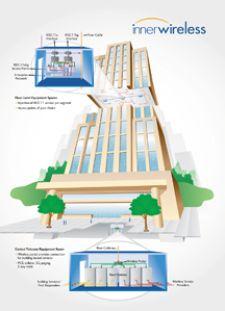
Photo courtesy of Welch Allyn Inc.
Patient monitoring has come a long way, and companies supplying that medical technology are continuing their work to ensure that the level of patient care doesn't depend solely on the attention given to alarms, the clinician who happens to be in the department at the time of need or the ability of staff to correctly enter what feels like an endless stream of data into an electronic medical record system (EMR). Here are a few examples of how companies are creating new technology and integrating existing technology to improve enterprise wireless monitoring.
Process automation in vital signs monitoring
Traditionally, monitoring vital signs on rounds is not only labor intensive, it's a routine that is wide open for error with regard to data collection and input into a system.
“We identified several problems with nursing staff having to write the information down on a piece of paper for patient after patient and enter it into the computer later,” said Kristian Johnson, R.N., clinical applications coordinator at the Minneapolis VA Medical Center. “The time element was an issue because it wasn't unheard of for vitals that were taken at 7 a.m., for example, to not be entered into the system until 9:30 am. That left hours during which no one could see the information. And then there were errors when the data was being typed in. You always live with these kinds of things when you have a manual process.”
So when the hospital decided to purchase new monitors four years ago, nurses requested the ability to transfer the data collected by the monitors directly into the patient's EMR. Welch Allyn offered to develop that interface for its monitors, and the development of a new product, today known as Connex, was born.
Demonstrated in the Interoperability Showcase at HIMSS in 2007, Connex is a Web-based application with ADT and HL7 interfaces, enabling data collected by Welch Allyn monitors to be transferred directly into the EMR with the push of a “send” button. The system will work with the Vital Signs Monitor 300 series, Spot Vital Signs, Spot Vital Signs LXi and the Vital Signs Monitor 52000 (now obsolete).
According to Kristin Metz, associate product manager in the New Clinical Solutions division of Welch Allyn, the real beauty of Connex lies in its flexibility.
“We spent a lot of time watching how clinicians took vital signs, because even in a low-acuity setting there will be several different workflows within facilities,” she explained. “We tried to build in as many workflows as possible so the product could be used in the customer's established workflow instead of forcing a workflow on the customer.”
Currently implemented in the acute care inpatient setting at the Minneapolis VA Medical Center, Johnson says the system has been well received by the staff and is under trial in the outpatient setting.
“Any time you introduce anything electronic into a process, often things have to change,” he said. “But I don't see any issues with Connex being adapted into various workflows at all.”
And while no formal analysis has been undertaken, Johnson says errors have noticeably dropped.
Additional functionality includes the ability to set alerts that are ward-specific, such that patient welfare does not rely solely on the clinical judgment of monitoring staff. Further, staff are able to leave patient-specific information for the attending clinician or other caregivers.
Companies combining forces
Nihon Kohden America Inc. is expanding its monitoring capabilities through a recent agreement with Masimo Corp., which will allow the integration of Masimo's Signal Extraction Technology (SET) pulse oximetry into Nihon Kohden's line of bedside and patient monitoring products.
A fast-growing U.S. market player, Nihon Kohden offers a variety of monitors, including beside and vital signs monitors, and telemetry systems enabled for wireless bedside and ambulatory monitoring. The company is known for cost-effective, innovative technology such as the Smart Modular Cable, which miniaturizes circuitry found in traditional modules and embeds it into the cable itself.
Likewise, Masimo also has a strong focus on technological development. Conventional pulse oximetry assumes arterial blood is the only blood moving in the measurement site, causing it to underread when venous blood also moves, such as when a patient moves. Masimo's SET pulse oximetry combines proprietary signal processing with the use of adaptive filters to report true arterial oxygen saturation and pulse rate, even in the event of patient motion and low perfusion.
Another convergence of wireless intelligence was announced during the annual HIMSS trade show and exhibition in February: Welch Allyn announced it entered into a joint technology and marketing partnership with Aruba Networks to enable the Welch Allyn FlexNet wireless patient monitoring system to seamlessly and securely operate on Aruba’s 802.11-based mobility solution. FlexNet links multiple devices such as ambulatory wireless and hardwired and wireless bedside monitors to Welch Allyn’s Acuity Central Monitoring Stations. It can support comprehensive patient monitoring networks while providing superior noise tolerance and communications integrity.
Location, location, location
A new alliance between Patient Care Technology Systems (PCTS) and Sonitor announced in May is going to make a new a turnkey workflow solution available that integrates Sonitor's ultrasound-based indoor positioning system with PCTS' Amelior automatic patient and asset tracking software. The integrated system will provide real-time identification of patient care milestones and the reliably accurate location of clinical resources for caregivers in areas such as the emergency, surgery and outpatient services departments. Caregivers will be better able to anticipate and manage workflows for safer and more efficient care as a result.
The Sonitor indoor positioning system (IPS) uses Detectors and Tags that are linked through the existing wired or wireless local area network (LAN) to a digital file containing all vital statistics and information about the item or person being monitored. The motion- activated Tag transmits a unique identification signal using ultrasound waves to special Detectors that use Sonitor patented ultrasound signal Digital Signal Processing (DSP) algorithms. The Detectors transmit signals via an existing LAN to a central computer that stores the information about the Tag's room-location and the time of receipt of the signal.
Sonitor's ultrasound technology ensures that detectors interpret Tag signals without risk of interference from any environmental noise or other signals, nor interfere with sensitive instruments.
Ensuring wireless coverage
The implementation and maintenance of wireless systems in hospital settings is an increasingly large headache, from interruptions in service that result in dropped cellular calls or pages, inability to connect to Web-based applications from laptop or tablet PC to troubleshooting.
And, as pointed out by Rick Gentry, vice president of Healthcare at InnerWireless, issues like these are more than simple inconvenience — in a medical center, it can be a matter of life or death.
“The monitoring of the patient, the clinician's ability to understand what is going on with that patient and react to it, is truly life critical,” Gentry said. “It's not like transmitting a Word document, for example, where if it doesn't work, you try again. With patient monitoring, you've got to have guaranteed, ultra reliable wireless coverage so that if there is a problem, clinicians can respond immediately.”
Therefore, InnerWireless has recently added Wireless Medical Telemetry Service (WMTS) for patient monitoring to services provided by Horizon, a distributed antenna system (DAS) which provides guaranteed wireless coverage and performance according to predefined specifications.
“Horizon solved several issues for us,” said Jerry Stassines, R.N., network specialist for Foote Health System in Jackson, MI. “First, we can maintain coverage with less than half of the wireless or telemetry access points required by traditional systems. Second, we could place those access points in an area that is engineered to be low traffic, so we can work on an access point with minimal disruption to other people.”
Stassines also reports that another maintenance perk of Horizon is the ability to load balance channels, making channel interference a thing of the past.
“The antenna system would be very expensive, but the cost is distributed because you can run so many systems through it,” Stassines said. “Besides telemetry, it takes care of phones, emergency and FM radios and pagers — just about anything. You know exactly where your coverage is, and you know it is maintained at an excellent level.”
Horizon is implemented as a customized system, tailored to predefined requirements of the facility in terms of both current needs and plans for expansion of wireless services as far as five years into the future.
The users in the emergency room have noticed that there are less dropped signals,” said Stassines. “This is a long-term solution for us.



 November 29, 2025
November 29, 2025 









